$DEFI Trending, Business Insider Featuring $DEFI, Q4 2025 and Q1 2026 Developments and MORE! – October Development Update
October was a month of strong growth and ...
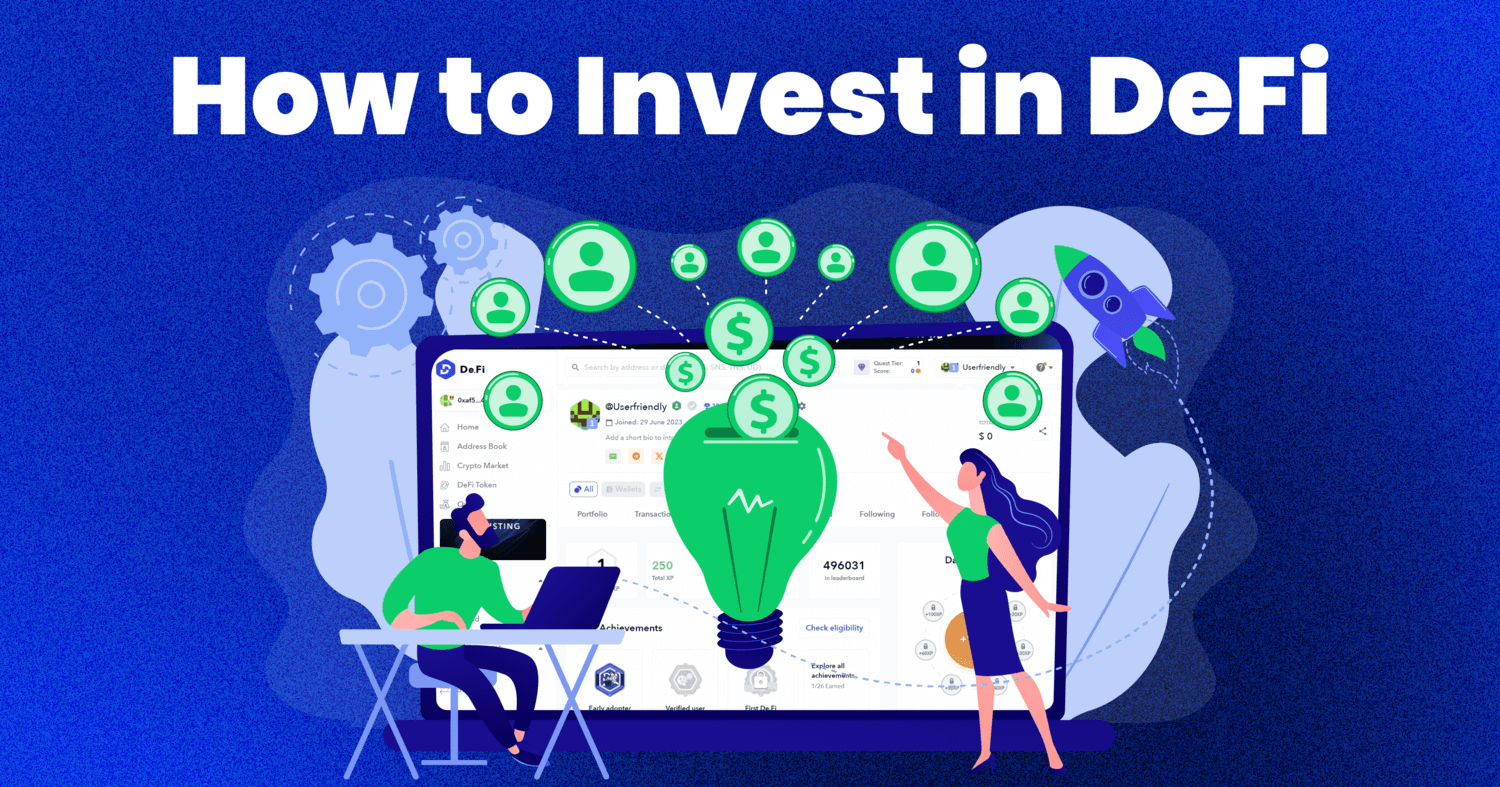
As the crypto bull market heats up, more investors seek to navigate the burgeoning world of decentralized finance (DeFi). This guide offers a detailed walkthrough of what DeFi is, the biggest DeFi apps, and a step-by-step approach to investing in DeFi.
Whether you’re considering your first DeFi investment or looking to expand your portfolio, this article will provide the essential knowledge needed.
Decentralized Finance, or DeFi, represents a shift in the financial sector, leveraging blockchain technology to democratize finance. Unlike traditional banking, DeFi investing removes intermediaries, offering users direct control over their assets.
The core of DeFi lies in its operation using smart contracts on a blockchain, with the Ethereum Virtual Machine (EVM) chains being the most prominent. Since the rise of Ethereum and derivatives, other smart contract platforms such as Cardano and Solana have emerged, capturing a significant market share of their own.
Regardless of the tech stack used, this technology supports a wide array of cryptocurrencies in the form of tokens and enables a variety of financial services. These services include but are not limited to lending, borrowing, insurance, and yield farming, all executed without the oversight of centralized institutions. This approach to finance not only bolsters transparency but also significantly improves efficiency, accessibility, and inclusivity in financial transactions.
One of the primary attractions of DeFi is the plethora of Decentralized Applications (dapps) that operate on its framework. These dapps offer various financial services directly to users. Some names that come to mind include the likes of Uniswap and PancakeSwap, which allow users to trade between tokens onchain and are likely to be the first port of call for those who are new to DeFi.
As one can tell from the above, The growth of DeFi represents a paradigm shift in the financial industry, moving away from centralized, opaque financial systems to a more open, inclusive, and transparent ecosystem.
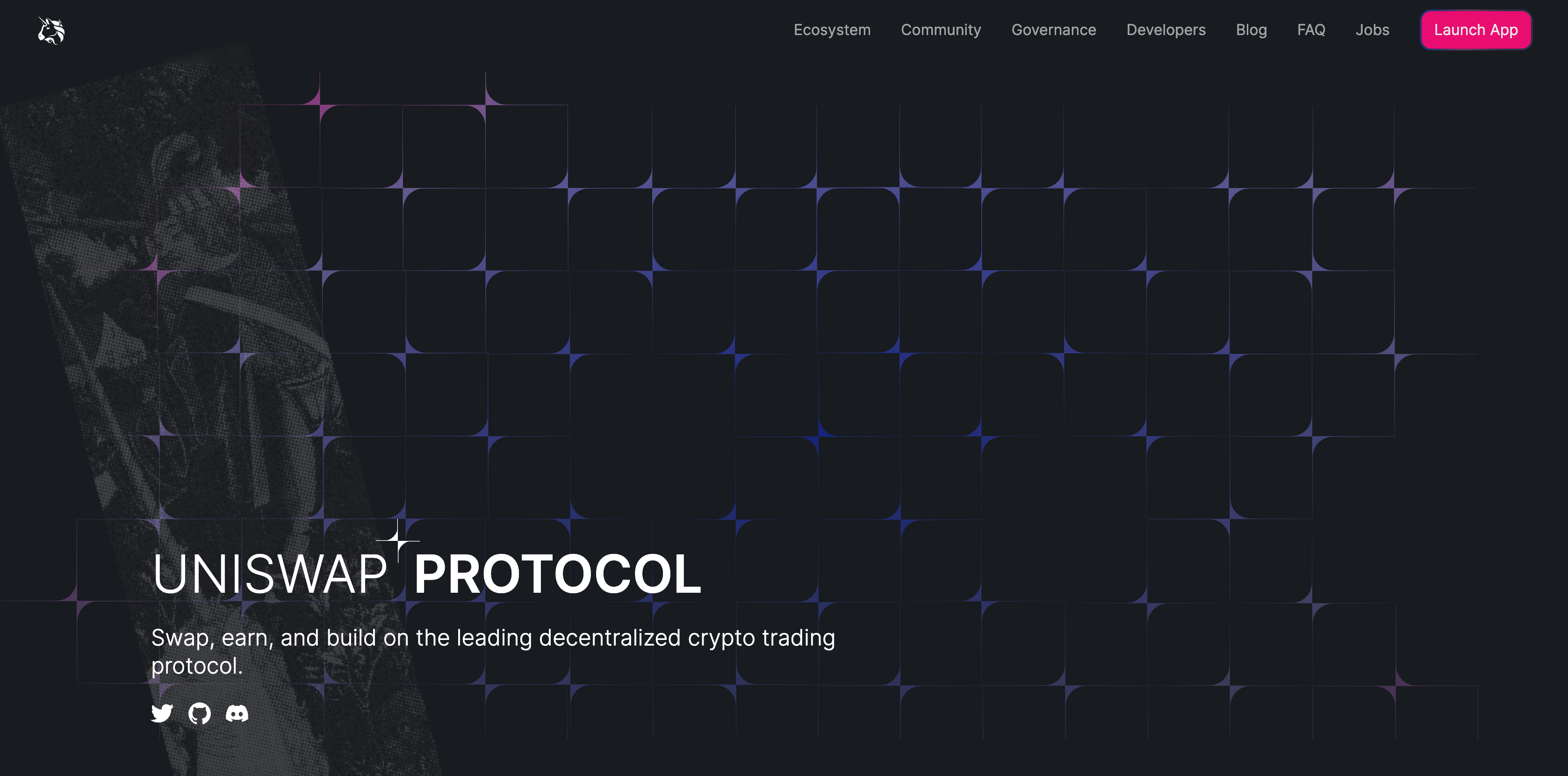
If you have been in the DeFi space since its early days, Uniswap should be no stranger to you. Uniswap is a leading decentralized exchange (DEX) that facilitates the swapping of various cryptocurrencies without the need for a central intermediary. It operates on an automated liquidity protocol, meaning that liquidity is provided by users who deposit their funds into pools.
In Uniswap, each token pair has its own pool, and prices are determined using a constant product formula. This model allows for automatic and permissionless trading. Users who provide liquidity to these pools earn a portion of the trading fees generated in proportion to their share of the pool’s total liquidity, incentivizing participation.

MakerDAO primarily revolves around two tokens: MKR and DAI. MKR is the governance token, allowing holders to vote on key protocol decisions. DAI is a stablecoin whose value is pegged to the US dollar, designed to maintain low volatility compared to other cryptocurrencies. The MakerDAO system allows users to lock their cryptocurrency (like Ethereum) in a smart contract to generate DAI.
This process, known as ‘opening a Vault,’ enables users to borrow DAI against their crypto collateral. The value of DAI is kept stable through a dynamic system of Collateralized Debt Positions (CDPs), autonomous feedback mechanisms, and incentivized external actors. If the value of the collateral falls below a certain threshold, the system automatically liquidates it to ensure the stability of DAI.

Aave is a decentralized lending and borrowing platform that stands out for its wide range of supported ecosystems. It operates as a non-custodial protocol, meaning that users retain control of their assets when interacting with the platform. Users can deposit cryptocurrencies into Aave’s liquidity pools to earn interest or borrow against their deposits.
One of Aave’s notable features is the introduction of ‘flash loans’ – these are massive loans that do not require collateral but must be borrowed and repaid within the same blockchain transaction. This unique feature has opened new possibilities in the DeFi space, such as arbitrage, collateral swapping, and self-liquidation. At the same time, this flash loan feature has posed risks to vulnerable smart contracts, with these loans usually being used to drain a protocol of funds.

PancakeSwap, similar in functionality to Uniswap, was originally launched on the Binance Smart Chain (BNB Chain), powered by the BNB token. It offers lower transaction fees and faster transaction speeds due to the efficiency of the BNB Chain. Users can swap between a wide variety of tokens, provide liquidity to earn rewards, and participate in other DeFi activities like yield farming and lotteries. PancakeSwap also features a user-friendly interface and additional gamification elements, making it a popular choice among DeFi enthusiasts.
In addition to being an Automated Market Maker (AMM) DEX like Uniswap, PancakeSwap also features perpetual swap markets, allowing you to trade with leverage, and potentially amplifying your gains. Since its launch on the BNB chain, it has since expanded to new ecosystems like Arbitrum, Ethereum, Base, ZkSync, Linea zkEVM, and others.
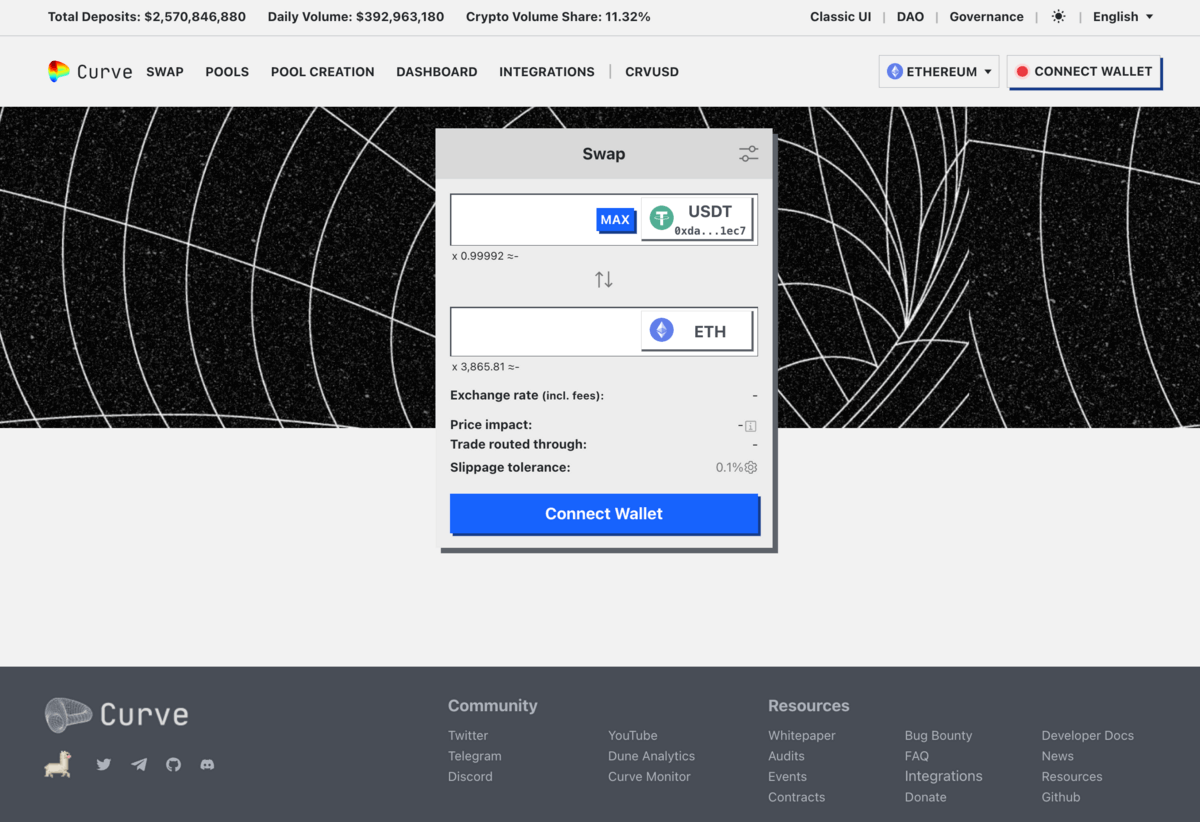
Curve is a DEX that specializes in the trading of stablecoins. It addresses one of the main issues in stablecoin trading: slippage. Slippage often occurs in trades between different cryptocurrencies due to price volatility. Curve uses a unique automated market maker (AMM) algorithm designed for stablecoins, which are generally pegged to a specific value (like the US dollar).
This specialization allows Curve to offer low slippage and minimal price disparity, therefore making it the most efficient place to switch between stablecoin types. Furthermore, Curve’s liquidity pools are optimized for stablecoin yields, enabling efficient and stable trades.
First and foremost, it’s essential to have a solid understanding of what DeFi is and how it operates. This involves familiarizing yourself with the underlying blockchain technology, smart contracts, and how these platforms facilitate financial services like lending, borrowing, staking, and liquidity provision. Check out our guide to De.Fi’s DeFi tools to learn the essentials.
Leveraging information-rich platforms such as X, YouTube, and Reddit is invaluable. These platforms host a plethora of community discussions, expert analyses, and project updates. Following influencers and thought leaders in the DeFi space can provide insights into market trends, emerging projects, and potential red flags. Follow De.Fi on X via our main profile and De.Fi Security account to stay on top of the latest trends.
When a particular DeFi project catches your interest, it’s crucial to delve deep into its specifics. This includes understanding the project’s purpose, the problem it aims to solve, the team behind it, and its roadmap. Reading the project’s whitepaper and official documentation provides a clear picture of its mechanism, tokenomics, and long-term viability.
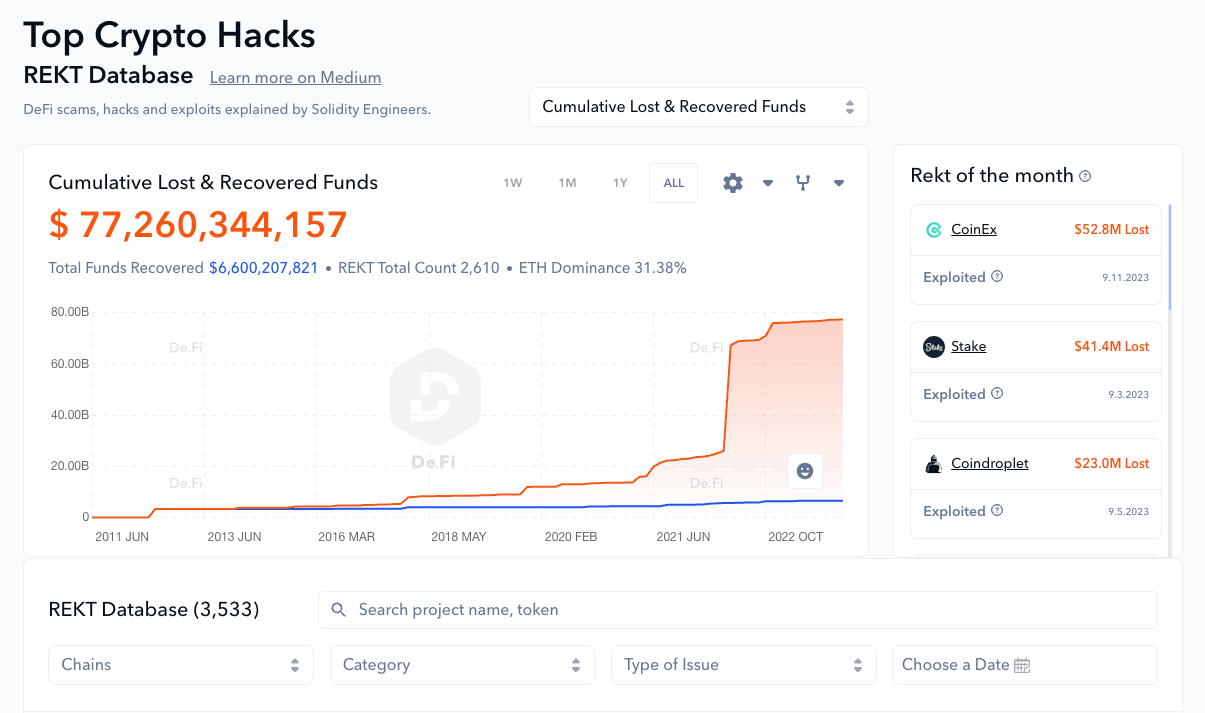
De.Fi’s REKT Database allows you to stay safe by learning from the mistakes of previous projects
Security is paramount in DeFi. Tools like De.Fi’s DeFi Scanner and Audit Database are essential for assessing the security posture of a project. These tools can reveal past vulnerabilities, the quality of smart contract audits, and the overall robustness of the platform’s security measures.
The blockchain network on which a DeFi project operates is a critical factor. Different blockchains have varying degrees of security, transaction speed, and costs.
For instance, projects on Ethereum might offer more security but at higher transaction fees, while those on newer blockchains like BNB Chain or Solana might offer lower fees but with different trade-offs in terms of security and decentralization.
Understanding a project’s tokenomics is vital. This includes how tokens are distributed, their total supply, and how they are used within the ecosystem. Look for projects with sustainable token models that incentivize long-term holding and contribute to the ecosystem’s health.
A strong, active community and developer presence is a positive indicator of a project’s health. Active development, frequent updates, and community engagement are signs of a project’s commitment to growth and responsiveness to user needs.
De.Fiers, you can be very proud by the work we’ve done in the last 2 weeks! 💙
— De.Fi 2.0 (@DeFi) February 27, 2024
We’ve made some great development leaps:
• Burn of 12,000,000 $DEFI
• $200k Quest (x2’d the prize pool)
• Our input in Academics
• Binance Square, Starknet & more!
🧵 Let’s recap our progress! pic.twitter.com/IXUR4J8Sf9
Follow De.Fi on X for updates on the latest news
Considering the regulatory environment of DeFi is also important. Different jurisdictions have varying stances on cryptocurrencies and DeFi, which can impact the project’s operations and your ability to participate legally.
Analyze the project’s performance metrics such as total value locked (TVL), liquidity, trading volumes, and historical price data. This data can offer insights into the project’s stability and user adoption.
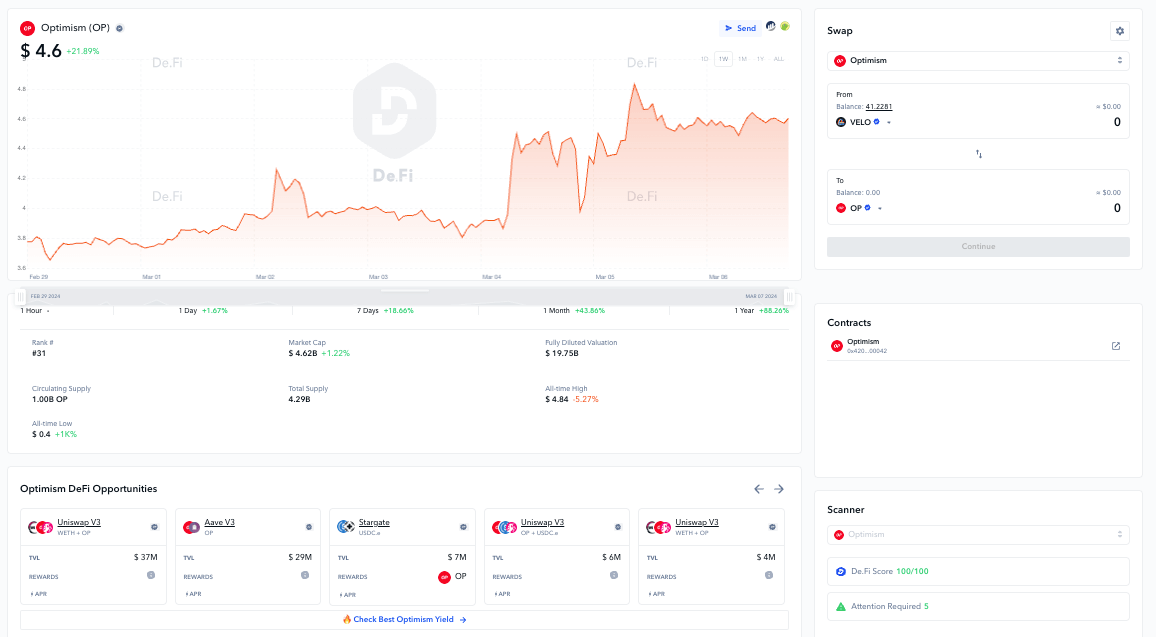
De.Fi’s token market pages allow you to research historical data regarding different coins (Optimism page shown above)
Finally, it’s crucial to understand and manage the risks associated with DeFi investments. This includes the risk of smart contract vulnerabilities, regulatory changes, market volatility, and liquidity issues. Diversifying your DeFi portfolio can mitigate some of these risks.
Researching DeFi investments involves a multifaceted approach. It requires technical understanding, security assessment, economic analysis, and active engagement with the community and ongoing developments. By thoroughly vetting potential investments using these criteria, investors can make more informed decisions and navigate the DeFi space with greater confidence.

When entering the world of DeFi investments, one of the most critical decisions involves selecting the right wallet. A DeFi wallet not only stores your digital assets but also acts as your gateway to various DeFi platforms. The choice between software (hot) wallets and hardware (cold) wallets, along with understanding the leading options in the market, is key to making an informed decision.
Pros: Software wallets, such as MetaMask, Trust Wallet, and Coinbase Wallet, are applications that can be easily installed on your devices. They offer quick access to DeFi platforms and are generally user-friendly. These wallets are ideal for active traders and those who need regular access to their assets.
Cons: Being online, they are more susceptible to hacks, phishing attacks, and malware. The security of your assets in a software wallet largely depends on the security of your device and internet connection.
Pros: Hardware wallets, like Ledger Nano X or Trezor, provide enhanced security. They store your private keys offline, making them immune to online hacking attempts. For long-term investors or those with substantial holdings in DeFi, a hardware wallet is often the preferred choice.
Cons: They can be less convenient for frequent trading or accessing funds quickly. Also, there is a risk of physical damage or loss, and they typically come with a cost. Finally, having a hardware wallet does not protect you from user error, such as approving a phishing contract therefore, vigilance is still required.
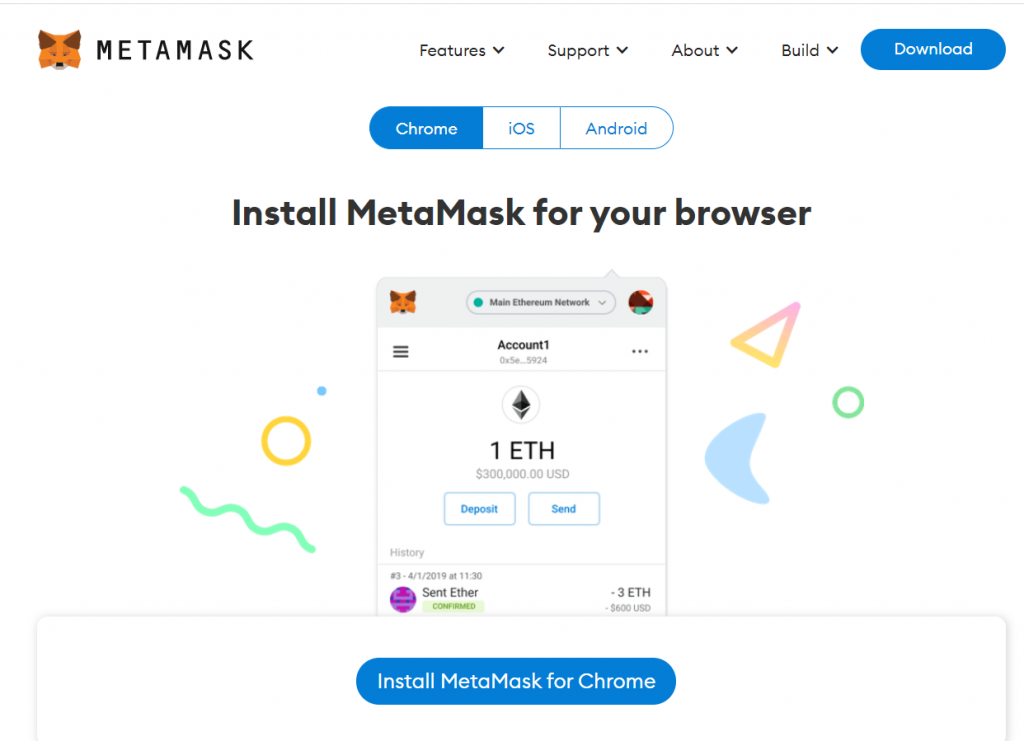
A popular Ethereum-based wallet, MetaMask is known for its ease of use and integration with most DeFi platforms. It’s a browser extension that also has a mobile app, making it accessible across devices. It supports pretty much every EVM network and is thus a must-have if you’d like to hold funds in the Ethereum ecosystem or any of its Layer 2s.

Acquired by Binance, Trust Wallet supports a wide range of cryptocurrencies and is known for its user-friendly interface. It allows users to store multiple cryptocurrencies and interact with various blockchains. Similarly to MetaMask, it supports EVM chains but also adds support for Solana, Bitcoin, Cardano, and XRP.
De.Fi Trust Wallet Safety Guide
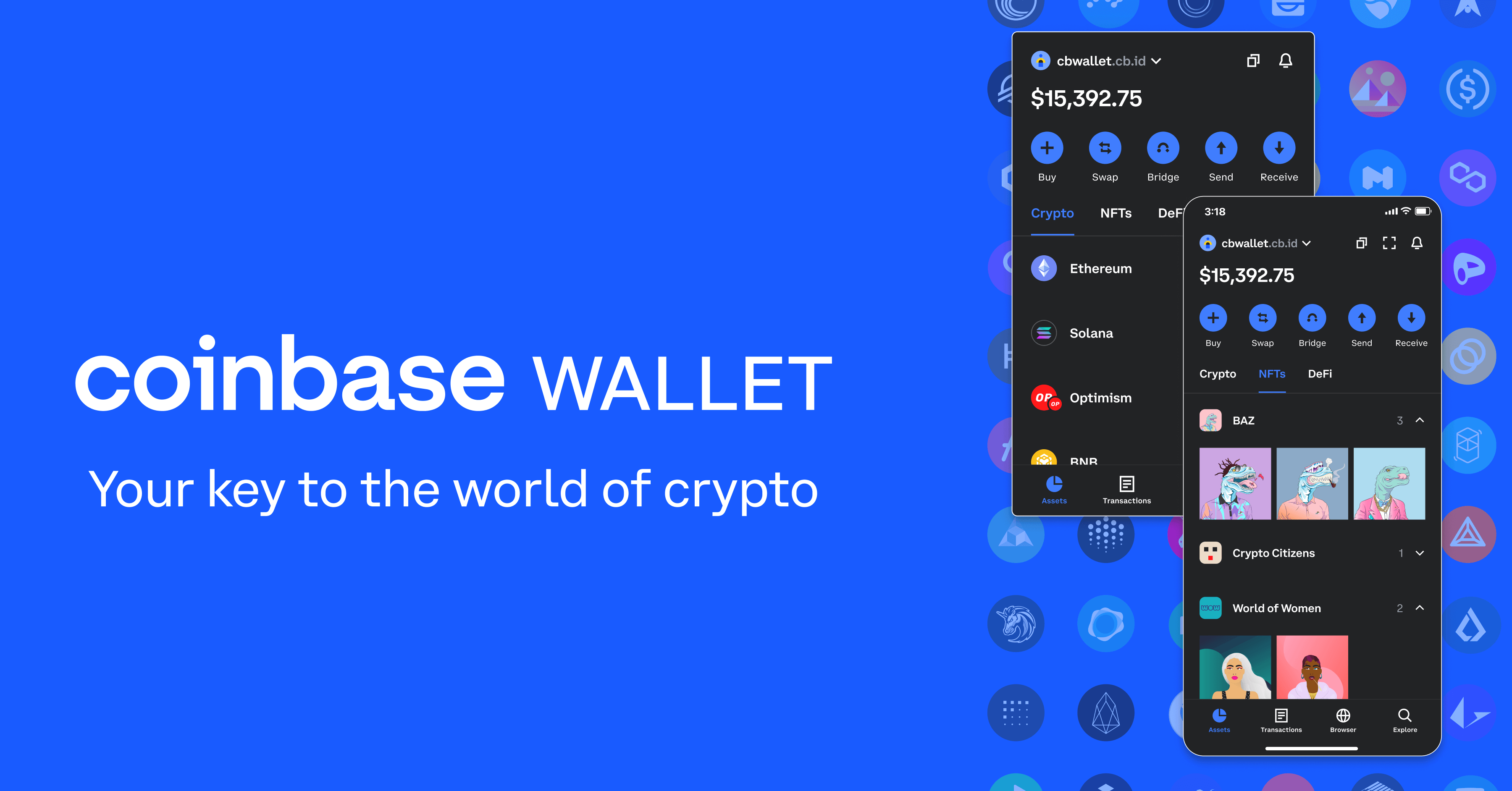
Separate from the Coinbase exchange, the Coinbase Wallet is a mobile app that provides access to a wide variety of DeFi applications. It’s known for its security and ease of use, making it suitable for beginners.
De.Fi Coinbase Wallet Safety Guide
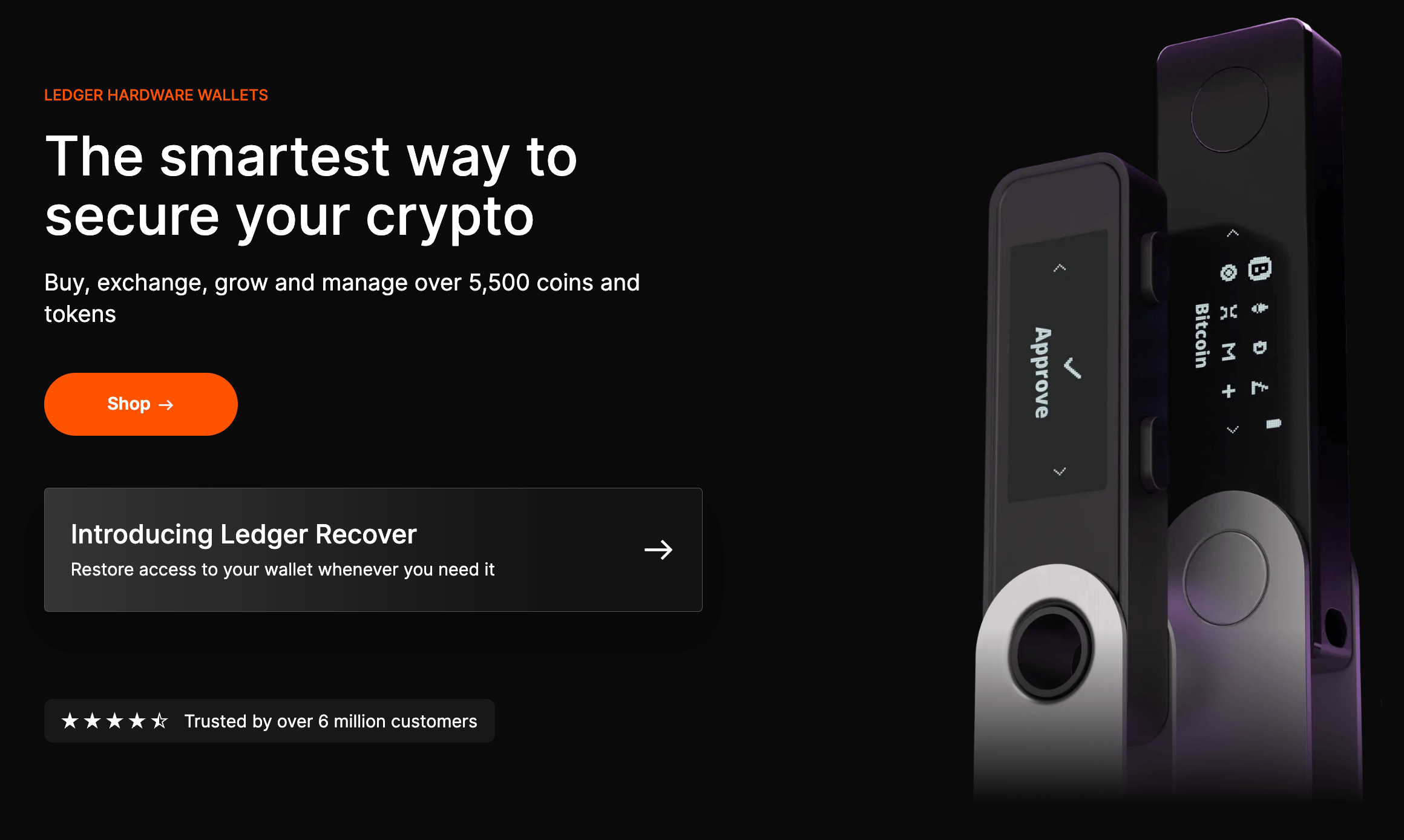
A leading hardware wallet, Ledger offers robust security by storing private keys offline. It supports multiple cryptocurrencies and allows users to securely manage their assets. This can be used in tandem with wallets like Trust or MetaMask in order to access DeFi apps and approve transactions.
De.Fi DeFi Hardware Wallet Guide
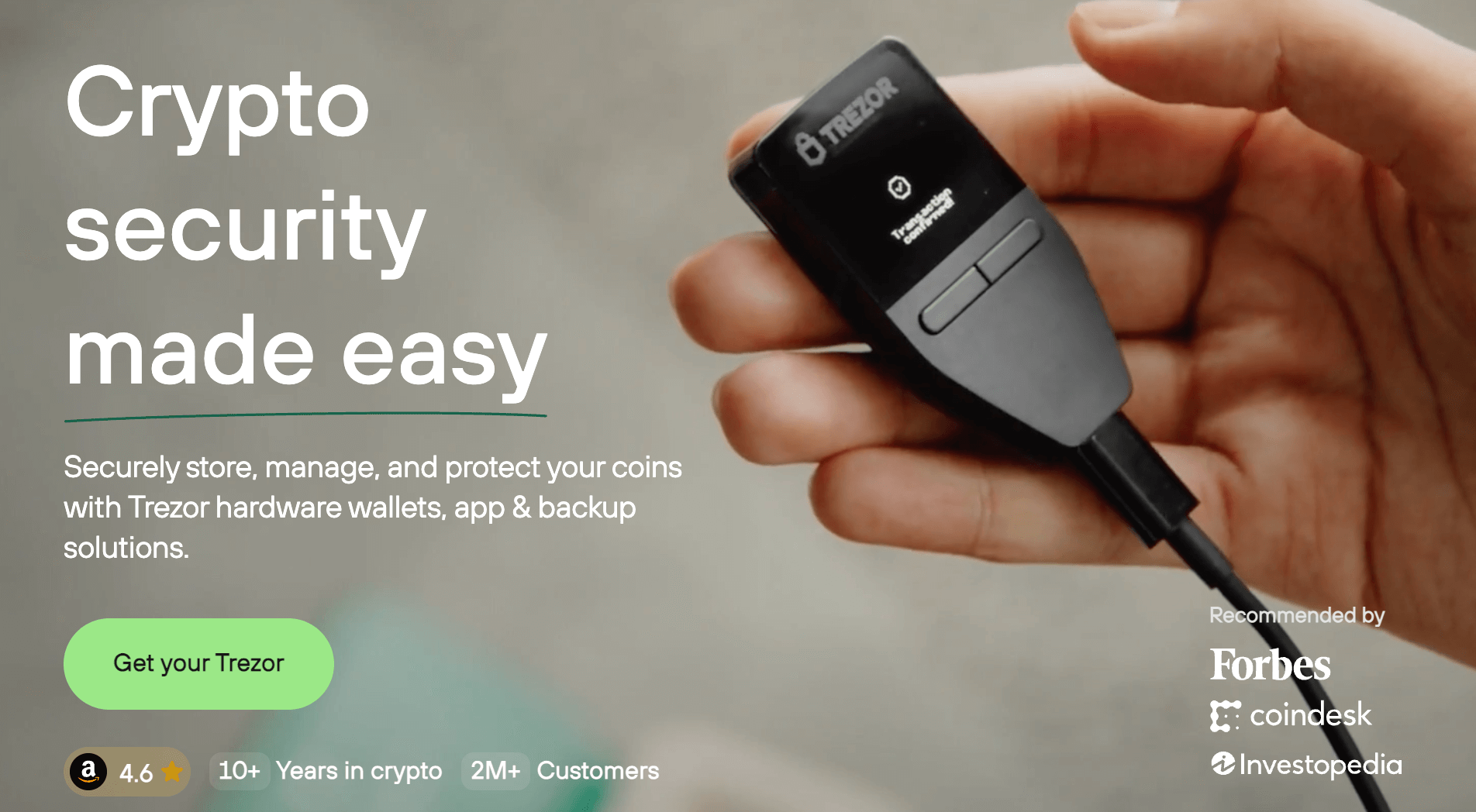
Another popular hardware wallet, Trezor provides excellent security features and supports a broad range of cryptocurrencies. It’s known for its strong track record in hardware wallet security.
De.Fi DeFi Hardware Wallet Guide
Choosing the right DeFi wallet involves balancing convenience, security, and functionality. Whether opting for a software wallet for ease of use and accessibility or a hardware wallet for enhanced security, the decision should align with your investment strategy and risk tolerance in the DeFi space.
Venturing into the DeFi space begins with funding your wallet, an essential step that enables you to interact with various DeFi applications and services. For most participants, the process involves acquiring cryptocurrency through centralized exchanges and then transferring it to their DeFi wallets. Here’s a detailed look into this process.
First, you need to get yourself some cryptocurrency. The most common and accessible method is through centralized exchanges. These platforms function similarly to traditional stock exchanges, providing a secure and straightforward way to purchase a wide range of cryptocurrencies using fiat currencies like USD, EUR, or GBP.
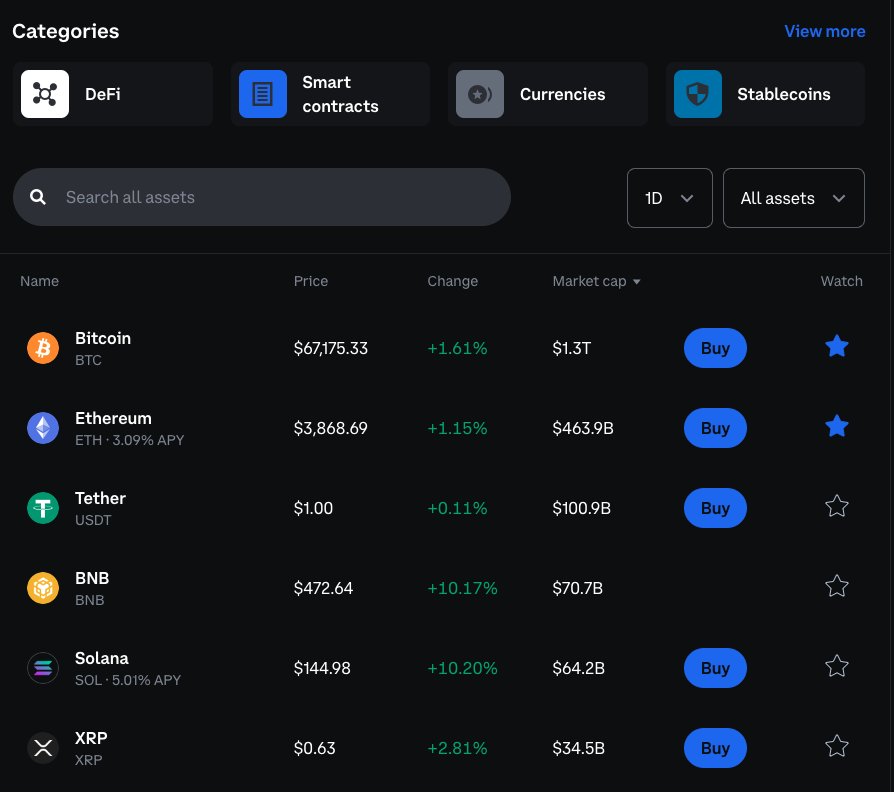
Exchanges like Coinbase are the easiest way to onboard into web3
Once you have purchased the desired cryptocurrency on a centralized exchange, the next step is to transfer it to your DeFi wallet. This process typically involves:
In some countries, you may also have the option to buy cryptocurrency through a direct DeFi onramp and pay by card through providers like Banxa. This allows you to skip the withdrawal step.
While transacting, prioritize security. Use secure internet connections and double-check wallet addresses. Also, be aware of phishing scams or fraudulent websites that mimic popular exchanges.
In the dynamic world of decentralized finance (DeFi), swapping tokens is a fundamental process for investors looking to diversify their portfolios or access specific DeFi services. A ‘swap’ in DeFi is essentially trading one type of cryptocurrency for another. This process, typically performed on decentralized exchanges (DEXs), is integral to navigating the DeFi ecosystem.
The process of swapping tokens on a DEX involves a few key steps:
Start by connecting your DeFi wallet (like MetaMask, Trust Wallet, etc.) to the DEX. This is usually done through a simple, secure wallet connect protocol on the DEX platform.
Once connected, choose the token you wish to swap and the token you wish to receive. For instance, you might swap Ethereum (ETH) for DAI.
Before executing the swap, review important details like exchange rates, liquidity depth, slippage tolerance, and transaction fees. These factors can affect the final amount you receive.
After reviewing, confirm the transaction in your wallet. The DEX’s smart contract will process the swap, and the new tokens will be deposited into your wallet.
For those operating on Ethereum Virtual Machine (EVM) compatible chains, the De.Fi Swap tool simplifies this process. It aggregates multiple DEXs, providing users with the best possible swap rates and reduced slippage.
Navigate to the De.Fi Swap tool:
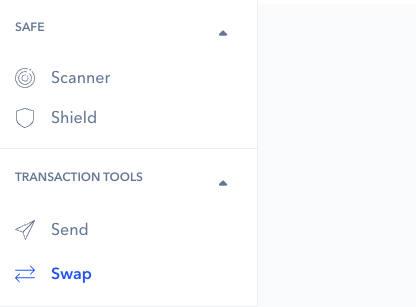
Securely connect your wallet to the platform:
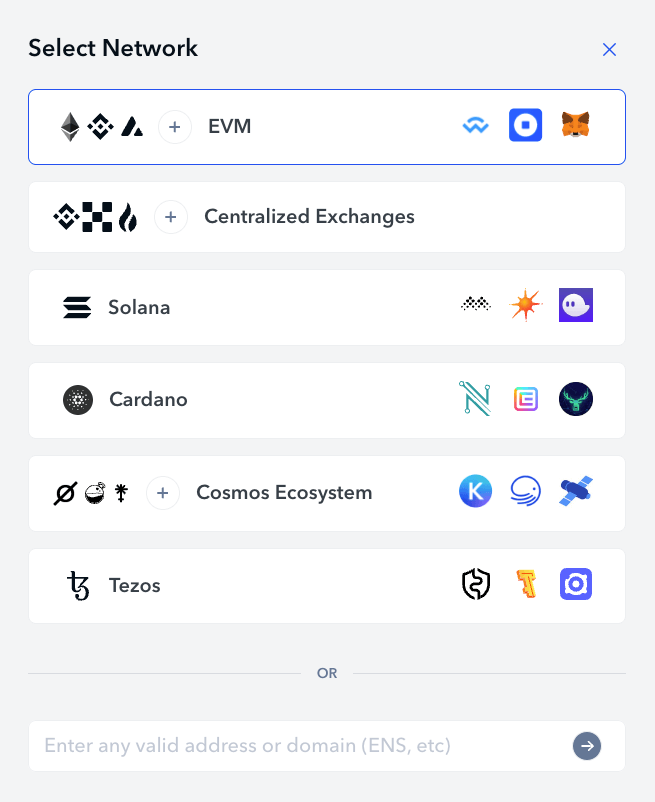
Select from a wide range of EVM-compatible tokens. Enter the amount you wish to swap and the token you want in return:
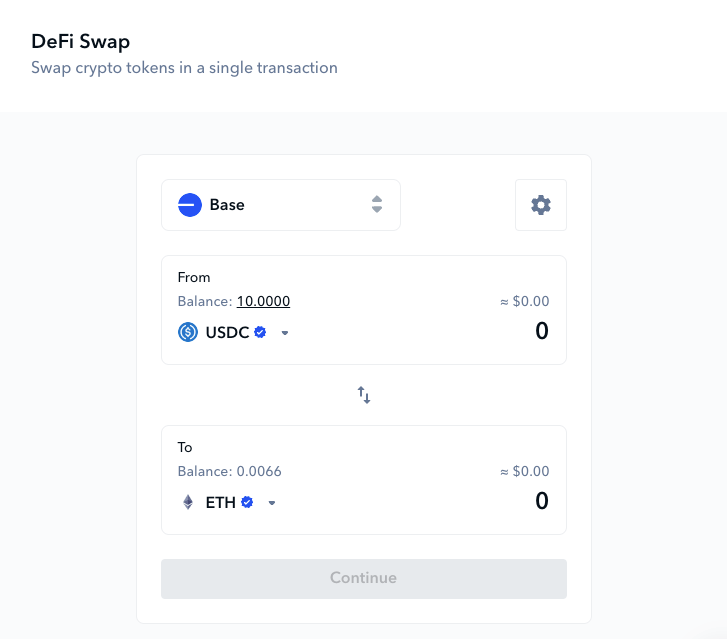
De.Fi Swap will automatically compare rates across various DEXs, offering you the best possible deal:
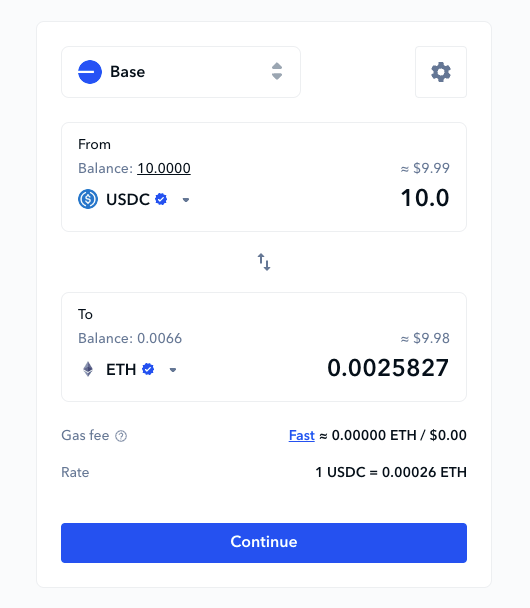
Confirm the transaction details and execute the swap. Approve the transaction from your wallet:
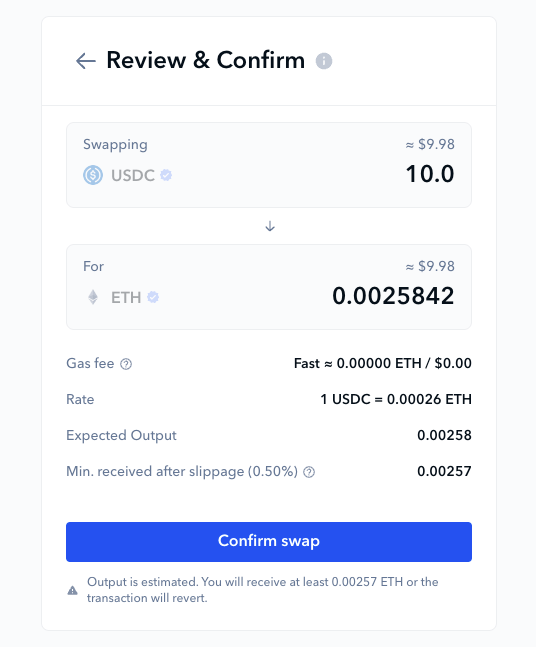
Following the swap, investors can use the De.Fi platform to manage and track their investments efficiently. Access your De.Fi overview page to see a comprehensive view of your portfolio, including the newly swapped assets.
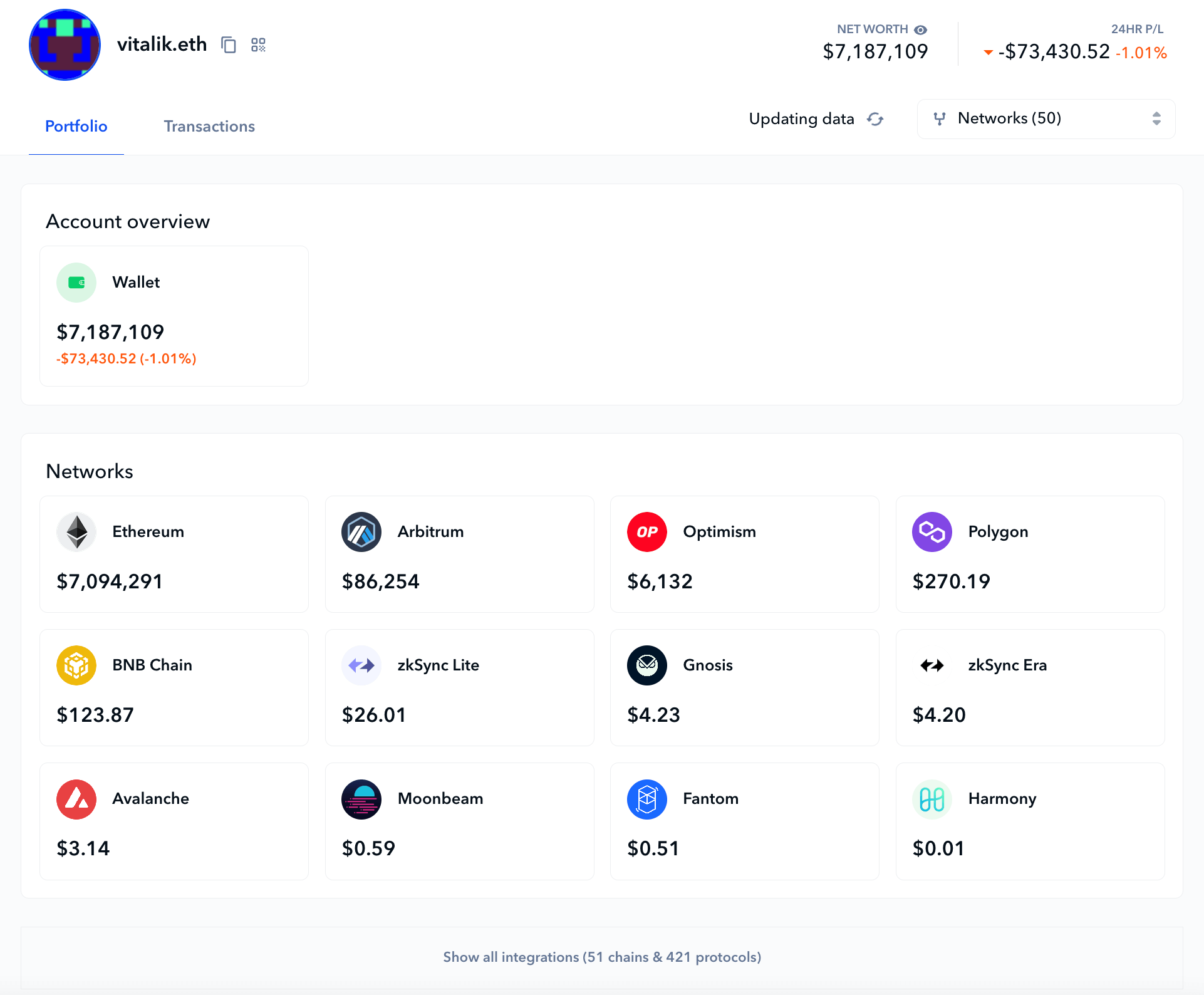
You can monitor the performance of your assets over time, analyze trends, and make informed decisions based on real-time data. Then, put your assets to work by using De.Fi’s Explore feature to discover new investment opportunities and ways to earn passive income such as staking, liquid staking, yield farming, or participating in liquidity pools.
Performing a swap on De.Fi is not only about exchanging tokens; it’s a gateway to the broader DeFi ecosystem, where your assets can grow and diversify. With its user-friendly interface and comprehensive management tools, De.Fi positions itself as a crucial platform for both novice and experienced DeFi investors.
Security in the DeFi space is a paramount concern, given the decentralized and often irreversible nature of blockchain transactions. While the autonomy and potential returns of DeFi investing are attractive, they come with the responsibility of heightened vigilance and proactive security measures.
Here are some essential tips to enhance your security in the DeFi realm. After all, transactions on the blockchain are irreversible, and any crypto that has been sent out is typically impossible to recover. So, make sure to treat each transaction with caution!
Domain spoofing, where scammers create websites that mimic legitimate platforms, is a common tactic to deceive investors. These websites often look strikingly similar to the real ones but have slight variations in the URL. Always double-check the website’s URL before entering any sensitive information. Bookmarking trusted DeFi platforms and using them for direct access can also help avoid landing on spoofed websites.
De.Fiers, you can be very proud by the work we’ve done in the last 2 weeks! 💙
— De.Fi 2.0 (@DeFi) February 27, 2024
We’ve made some great development leaps:
• Burn of 12,000,000 $DEFI
• $200k Quest (x2’d the prize pool)
• Our input in Academics
• Binance Square, Starknet & more!
🧵 Let’s recap our progress! pic.twitter.com/IXUR4J8Sf9
The foundational step in DeFi security is ensuring the device you use is free from malware. Whether it’s a computer or a smartphone, your device is the first line of defense. Regularly updating the operating system and security software, using strong, unique passwords, and avoiding the download of software from untrusted sources are crucial practices. Additionally, consider using a dedicated device for your DeFi activities, especially if you’re handling significant amounts of cryptocurrency.
Your wallet’s seed phrase is the master key to your digital assets. Losing it or, worse, having it stolen, can result in irrecoverable loss. It’s crucial to store your seed phrase securely and privately. Writing it down on paper and storing it in a secure location like a safe or a lockbox is often recommended. Avoid storing it digitally or online, as this makes it susceptible to hacking and phishing attempts.
If feasible, use a hardware wallet for your DeFi interactions. Hardware wallets store your private keys offline, significantly reducing the risk of online theft. They act as a physical barrier to hackers and are ideal for storing large amounts of cryptocurrencies or for long-term investments. While they require an upfront investment, the security benefits they offer are invaluable in the DeFi space.
Phishing attacks, where malicious actors attempt to steal your information by masquerading as trustworthy entities, are rampant in the DeFi space. Be extremely cautious with links, especially those received via email, social media, or messaging apps. Always verify the authenticity of the source and avoid clicking on unsolicited links. Remember, legitimate DeFi platforms will never ask for your seed phrase or private keys via email or direct message.
🚨 Phishing Alert 🚨
— De.Fi Antivirus Web3 🛡️ (@De_FiSecurity) February 27, 2024
Crypto user lost ~$203k worth of $USDC ~3 hours ago
⚠️ Take caution and always check the links you interact with ⚠️ pic.twitter.com/I9plQvvcxB
De.Fi Shield is a valuable tool for monitoring and revoking wallet approvals. It keeps track of which platforms have access to your wallet and allows you to revoke permissions that are no longer needed or appear suspicious. Regularly reviewing and managing wallet connections can prevent unauthorized transactions and potential losses.
Before making any DeFi investments, conduct thorough research using tools like the De.Fi Scanner. It helps assess the security and legitimacy of various DeFi platforms and tokens. The scanner examines smart contract codes and audit reports, providing insights into potential vulnerabilities and past security breaches. This information is critical in making informed and safe investment choices.
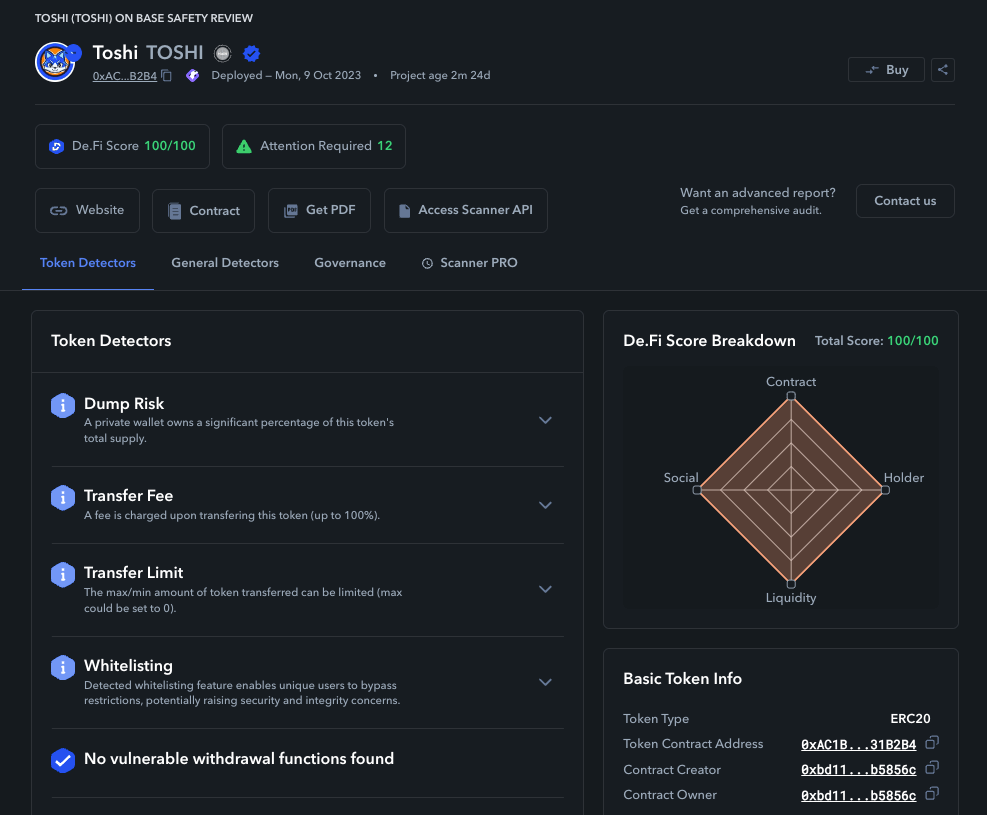
De.Fi Scanner results for Toshi on Base
In addition to these specific tips, there are other general practices that you should adopt:
Overall, navigating the DeFi landscape safely requires a comprehensive approach to security. From safeguarding your device and private information to being vigilant about the platforms you interact with, each aspect plays a vital role in protecting your digital assets. By following these security tips and staying informed, you can significantly reduce the risk associated with DeFi investments and enjoy the benefits of this innovative financial domain.
De.Fi stands as a comprehensive resource for all web3 users, offering tools and resources for secure and informed DeFi investment decisions. Whether you’re a seasoned investor or new to the space, De.Fi is your go-to platform for navigating the world of decentralized finance.
Make sure to check out the De.Fi SuperApp, whether you are looking to guard against crypto scams, make a quick trade, or check out the best possible opportunities for you to deploy your funds.
October was a month of strong growth and ...
September was a month of global...
August was a month of major...
From major Explore Yields upgrades to...
June was a month of big releases and improvements across...
The end of May brought important updates across...
© De.Fi. All rights reserved.